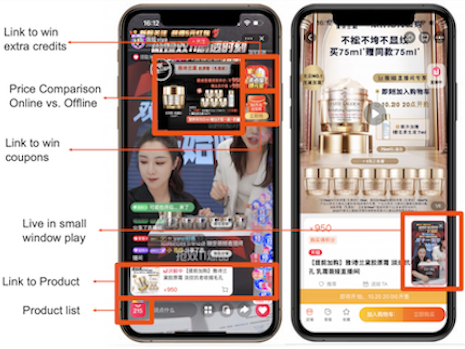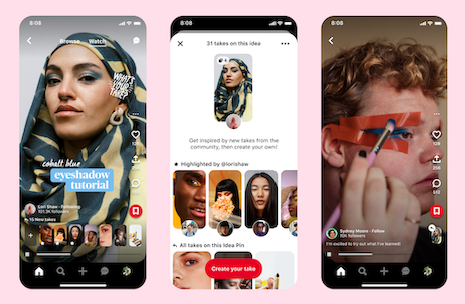NEW YORK — Ecommerce is getting a facelift with the emergence of a highly effective, more engaging category: social and live shopping.
While livestream shopping, or live commerce, originated in China, it has recently infiltrated the Western market at an alarmingly fast pace. During a session at Luxury Daily’s digital Luxury FirstLook 2022 conference, social commerce executives shared insight on how brands can effectively utilize platforms to reach highly engaged, digitally-savvy consumers, from shoppable content to choosing the right ambassadors.
“Consumer shopping habits have drastically changed over the past two years, and consumers are increasingly turning to online platforms to inspire their next purchase,” said Alexandra Nikolajev, senior lead of creator content and partnership marketing at Pinterest, Los Angeles.
“They are becoming more personal, so as a shopping platform, we have made significant investments over these years towards creating more personal, engaging and inspiring online shopping experiences for our users,” she said. “It’s no longer just about the purchase, but rather the moments leading up to that purchase.”
This session was moderated by Mickey Alam Khan, editor in chief of Luxury Daily.
State of social commerce
Driven by Gen Z and millennial shoppers, the $492 billion social commerce industry is expected to reach $1.2 trillion in the next three years, indicating a crucial opportunity for brands and retailers.
In March 2016, Alibaba’s Taobao launched the trial of its livestreaming platforms, and by 2018, the category became more competitive when short-form video platforms Douyin and Kuaishou entered the market.
By 2020, China reported more than $162 billion in livestreaming ecommerce sales, with 617 million people having watched livestreaming shopping events (see story).
 Taobao Live, Alibaba's live shopping app, offers a multitude of options within a livestream. Image credit: Fashionbi
Taobao Live, Alibaba's live shopping app, offers a multitude of options within a livestream. Image credit: Fashionbi
“Last year alone, China reported more than $435 billion in live shopping sales,” said Vincent Yang, cofounder and CEO of Firework. “People are selling houses using livestreams — even Tesla was using live commerce to sell cars.
“A simple image or video is no longer representative of an experience,” he said. “This requires live stream environments to actually show products or services so consumers may ask questions.”
Having proven greatly successful in Asian markets, social and live shopping has made its way into North America and EMEA.
Media platformssuch as Instagram, TikTok and Pinterest quickly adjusted their technological infrastructures to enable this new category of live commerce.
Just two months ago, Pinterest introduced Pinterest TV, a series of live and shoppable shows featuring the platform’s creators. Pinterest TV episodes will be refreshed daily, Monday through Friday, but are recorded so that Pinterest users may view them on-demand at any time (see story).
“Pinterest TV started as an idea to help our audiences and our creators connect to easily teach their passions,” Ms. Nikolajev said. “What we saw, though, was an audience that was so highly engaged the idea evolved into shoppable content.
“One of our star creators, [Olympic diver] Tom Daley, saw a 4,000 percent increase in followers after one episode on Pinterest TV,” she said. “This format is really skewing high with Gen Z users — they are commenting, reacting and staying on the stream longer than any other audience.”
Notably popular among Gen Z, video sharing platform TikTok also launched a new suite of shopping tools, including Live Shopping which will allow brands to engage with users in real-time through livestreaming (see story).
 TikTok launched TikTok Shopping in October 2021. Image credit: TikTok
TikTok launched TikTok Shopping in October 2021. Image credit: TikTok
“It’s fair to say that live commerce could be considered the QVC 2.0,” Mr. Yang said. “However, the ways in which Gen Z and millennials consume content is fundamentally different from how their parents might.”
As Gen Z is the primary audience in this emerging sector, it is important for brands to consider how their products and messaging are resonating with these authentic, value-oriented consumers.
Authentic endorsement
With new formats for marketing and selling products come new forms of communication. Old-school advertising and high-brow celebrity endorsements do not necessarily work with younger audiences — in fact, they reject this type of messaging entirely.
“These consumers can quickly discern what seems real and what is not,” Mr. Yang said. “A brand hires a celebrity to promote a product — Gen Z will say, ‘no this is fake.’
“They prefer authentic connection,” he said. “They want human connections.”
Celebrity spokespeople are not connecting with younger audiences the way they may have in the past, so, now, celebrities and influencers are being hired as creative directors or helping with product development.
For instance, American supermodel and influencer Kendall Jenner was named the new creative director of online retailer Forward, stylized as FWRD, in a push to build its audience and reach younger consumers. In her position, Ms. Jenner heads the look and feel of the website, curation of the brands sold, monthly edits of must-have trends/looks, brand partnerships and more (see story).
“We are seeing brands trying to find that organic connection with a celebrity by bringing them into the fold through the design and planning stages,” Pinterest’s Ms. Nikolajev said. “Ultimately, this can help authenticate a brand’s voice and help connect with this younger audience.”
{"ct":"0H3hvc2un+bYSUkP4E+eQQCzEg\/JWdE3UmVph1FGIYsihV47eUzP0+cwIe18+Qpl4zJmJgb7kmqVgNc5nIRuJrFYuQLzLVqueBgFwGJj0RMJFjxEmxHYnbJFVk5OuHY5VG6hVJjH5RynIKLwnwid++wLr4zkLhIlsVaTpAcG+DBx9rT4KVHssCDqupySLJCJomjzwZQRjZtK9KBj5olgAlgQfFu3WNKUXY8otcS+lNOAp8qCftiZBztC+h7Rp8GLmcaqBlozn5Pj03deArNxMYM0400+sWI\/se9trDCY\/VhiBF6Njvr+srETKhjkcxDpwsb44w2xGgxkkdxEYLJY8xc8ApcRTfDx2H+NcFLXqwl2ymQgwyjVsextWa\/FKo+Y5NZCAIWEsX26X8n69ipx\/3zVTtmbPaAzTHB\/SYMzuSOUUNMw3NrCNAmo7mnXeACa+Pu9p1MR1yAfBm34wnnGwCsK2rhwh28nr8hH0EBCa3aWR1qUMs5FdyGN86Cy5TwZpFS9a\/d1e25gzDtmjBRrljJCdJ8CsxnsPVSAMl4\/diimdyirUj5MKCfeCXbyA94lJoftLV0hRE2j0V5+BzZQ\/NxadfITcoCQ+ZO8R+wh72L3LukIDLIDgz+FkCNnI147rzwpxsiXd5ho+xJFP4718AA0ZbpgGJ3tBzqQXbmfR21Pmm7LZ56VCON2PPG5uP0pO\/F0j2OXZ3abcYD+v76PhO1yDAegtA\/r99u2tY38RYXlH0zOPgfzDpD8fzCGEorS1mtFF6CUxLtii2jnttEYIxvFA4mTVB6eNk3QluzUuMau5AYvxKqXLPYDmvM6MbZGnxerX+A26i3ZRFHk8BFAcR5BJ2WaIf\/TizVBSbQnjHM5NHg67KD89OsTRp7wmHcVdsDEfBj+EKBUwZ4WOz9lbDCCDy\/xoYdX\/QgsekQzL+PXkXH9tNRD9C2cjdeI4Q5CB78I6dCdg0X+Q5EfSwc6bvzV9FXQc1+DjADaYpyATSuRe8VvO+rdMIBtHbuV7od\/EcRSSaoLNFNrwWUEag23tUdZbhTu3qALinuVWa5yprQOUgvHsXGXTpyThM4++fAnvDsNfc+LsIutu184v4ZzDzUXQzkFm9VYPCQKgPhf0xTni6eELawMHLb9OhfD0hxfcJ44+AvwaaEJctL5NtNXW0xsqhHae\/z54wEXVeGGftLCwmAskYUCFLIjZtKTFgD9Ktg7nv1flCkIIXl4uw4SjkB+2pYYBbx4J1MOgt15zbi9s4qK0lKthtRP9YpEt3OhzmMLVjsX+aR4mBEoDMj8AobYZxFZhZx+y4u\/KtS5GshtJ5kq\/VKJI4ttYjzCr\/IPATekM94RANtoNX8EdPcdKo79lhj5Z4vgXHvp2W4nvbim4\/kEFXNw\/A6z\/FlT3ZDEY2a8LEDyqCDnHoFPxr\/FWTt6XlJbAbfBhEVlEV5DN843xJD7FMJzOb\/UZpDkWbHPh\/pX8RP\/iNz4tT50LXUVnKVh4G0MpE0LRWG0wkwTYIf66CQZDbMO3RM1pjG+64Q1jdhtcMnWywxRcwaxMYYLogwi32X5g9zTjGWkVMLgAfJDVuOvHHrjmzSVLwNBdjG8eRjFiNKOz3o1amuLKrQYowtjVsAhULLBiYmaI6Prc8yKIHEGHUpXqoaPjAL027j4GmqwQG0SC+UbLuIGqvb4\/6EFfoxArWpHlWzHNhL8X43MjMBi4gEi5jgcPdRqDsyEildkaFIXPW5IpP0fBIjB9mQ4XizxD7cGVHNo311sOZNyU82wEifoBtrWZGL1VlNh+qw7ATpW2LRB6LhUStjPbyBy8keoUO42qKz8rI3Q1m7rqsAmcGBW\/QpDOztrCZnVnlnLiYx7UswBDo8OgH9EyXltbx05rsoAEqUyKv8gOYf6wFmlyacmH0nINwt6jtnvpJ5pamUi2egg\/0dFAAC33836lBFZxfI1xokZ08asyA112UH798LP3V3SYDql7hw\/iRfMVSd4BWYe4k7Bi6vV\/U8DjKsUe\/\/3WyWnfr3Jjx8wlyshjGq1+JvZhqGjxT7Xx8LwMZ4txldMbaBVE3pWEdafUzYjd1pfj6q5Qhw6z5Rp26ic0TJi2xLmFmLd1MteXkPhSQR1KV322onJHNe1O9u\/lgKWhOfIW4MMbBn\/DzmsP\/cYfRzm28wp9eyGG8yHM7Ju5QM9S4AAr0O\/0T8+YLLe46zRudLAdiArUbs7aX1U7mU8z6Oqj030PbZKXisPWbVGfOdJnOvxj7ac7ruNe3dV4iSZpkB610GCJ1eGEwfj62jVr7Yuiydv2ZpLio9HZZ\/V9EKYib5k0J3IEJAVic+bBZqA\/AoDCvc4cgnzvNDPZ3BZyAfhnuMxJeHxITE1B76poS7WRPgUvS45L3SWVQ41xKfuMGr\/XqmeBLs9F6pnM81ITLn62JlhuGb7N2+2pFc8ZJ+Oykur2jHKiQiRkqQl7eTernjHCxKDKm5o+QK2nKDqtmHEt7VfpNsagX471u\/9cz+9U3fsXAI9S0Jv1x\/lp95o190S67r+YGJuaA2djIGhkZnxVz0GwDX0KO6exWmrYzG2eMN1uezR8xQlKhkwNfkmeqZySJv8kdm+FBSFr4ppcxEdFg24200+TwUI\/zLz2XtMum+PRcI97KyrkQyI7DtK1S9mnPJp07b\/SVLmdBpI2qENci4P7HL8SlYaO1wHOnZ61nfz1q53Feq0NcCJoNlD+NpAP6\/y27229\/XXK7qB4xUeCzhZNHDBdczASEEd7M9QvGHORUgW7ibsR45pzRrzSITHI9oNgfm\/JmX9cWo\/bM8R7imLkeTxlKqGyFNQACevbeuxrSRNx2YwK8\/Z54QrKSqDgDzgke4YK9KdchxVObUtFwhFaOxifvu70p9UvYge2l3Ddksk8f+TrYl5Y\/h1k7pt1Yu0zSJeRO9JDFgoRP5XgwGHmMxBQwC2TF+n98c0thqmgwG+DLjTYF72JmRnpVN3HQ3YAlj0o4iriuCK9yP7houdKt5UucxLyKF5j0NhXaiIC7lA+cTgzRvi4dTjix03QE3bHiDa6cEzI1yEHZI1Zax0pekbUOc4nQ\/RfmQ0iVH8MGmkaV5T+bKKL8dUOJGicrNNVQ0yz3k6A+0OepBRCjPR4ck4t9U2ZCoQeM9lU+PKeDJ1AANoih8Us8kuYrpKMEheyMJUIoFY8QHbtN\/vQF3pa7fCdSvs1Cb9Hp3Bki7uSSbdGI0aANtAeEHjKAPbH4NJkHxoqY2+lKThvuhbSQGpFb1i08CQ15H67EC10GL9BkbhGoztwGmJnpaCXAtOTtlkFUWQBgZzgzFxnAF3yT9ajKS67xhtG5ZtA\/n3z07jASwbsO+qsGxwZx23PL6qRoYYDXXqPWesoj75ChSsCLHPsgGjruB8E74jPq9sWx0RfDIpCn3d3QeSyIcGGfFKMzi86g6iRkwjKQo9ksT\/3otNB9\/m71ZMklwuEif7FqZ4sNy0JCuC3KUSKr7HmwMivKdIF\/lJkZAe0YSRjjpCDwC4n4dEn36yQtPgjdxpQqNYN3FkWjrFRGiv\/B0EYJNaHuwMVfkbMCFu7iWQac4xm23FlNm04gr+aqZ5Tb4WAqGeDxtSQjttQN1IyZuQoHlnybamhDbiwT1ukQK0mDEzGgzYlaR\/Wq\/uSLD1sRYribAHl\/MTeU7B096JZxUAR00qeUIXf+cKjcnNsoYII8l+gPU23\/jRAJzlvqMQ3rKQu+vPi4OEROST\/kdUcBcC+0TEq8PDMZ84QODMnUyXAxz871p0ZOE8MH6P2VDFjemhLKxJBzA2u1z6RKxc9jGgJ+I5bdfi1O51QYpRl0QCDoZjX6iYg1L9tKLPtnDv2We5dUcx4rB9l3xQk3OAul4WFOs4WufFkRFOxU44W7DJXvmAmnnsY8qXEm6mvJHe\/LzWRd5a0NF1hGF\/1q+67XMK79dDuALA8iNs11wIDk3\/a\/axKkPit3qr67NOjM9+RAa3mtceJq2rNweS+dEbNH1aahsj6tRbnR+d8x90w3Jy0F4q5dZ21tj287DzhnASRzBoNT11hbcvPOdnMs+gQYdwFFRDKAjkJA8dkOyYayaTsD7XqffKcgUfGVG3q\/4SFzkpSYvAk9JRQrCwrg3U\/Vyo2emJaO7rrGrOGSaLj52IuQEoerwQVTKklLPKF0cX+b7etMHWYY\/9o8ddQ9xwoI7RhFEZmiR4FD6ErcCAk1\/16A0bl2Np5X+wYY1+GNMwnH8CVcSKpj1AxkfzB1mtPTFdPs0BwN2JAcPv0Msvh1l3HNDK0D98q4zMLHDNKRyY8kfRQvdBAy4dyqFqyqeAuoPG\/9r9BFcw3oVWRJeWiex\/Ka+xjgKUNY1Pa8LrI1fgRI5jagD1kunqItDzkuH4ju+8npTm5Ossm+m60XQfhBZW3zrTJudhRP16FUXOfbbhdhtgl1E8EOIlE8T1bQQQfUxyR2V+e5YV5HZpOfP3ONbVVm+fQ\/Dh5Sw6eCILC1rcZgqQIOktAW+z06GWBeEYNPq4BAcPEDvDM+pLIy+yUu7Ollyol847O1\/fSiJHgw+cJszEu0Gc7yiCoZLPkLnpDss2CJnKb22MaWahrqrcUpjd+WntcBzuc5jetGKr+BDvJN3OmpelsC7ckJ9l6CRRSMljitDtzCHLRnkLFva6cRRqHxds6oa5kgS7dtrVMEfuVjPkbfs3wbgSviJCMKEE5dL6gb+2XVanO6TPq7t4AfgaAnI4yQhZZ7Co7FjuC7iNtzz\/TsfT9LhrE4tWgCZWo2NCgho2I8EWA8D\/a5j+kggNAsd+glvPPK0fbNChdtG1aD64WfJNXa3gKF0PbbRa5FgFgxZ5phIBexCmeL99cI61MnD0eg2KSYTwVnEit+PQAbcy+LEtpsDR5Pi9ygRCyFIPPL1OH74g5ESqrXmjp7LdAbWBkhEpMvWXkGfSA9WygUU94byJkt4Bph4PiYTsGFzAcn0DlIaUb95ylNKPgnEdk4bKa4hXZr9sI\/Vm5IPaUOT3HloP98lNoFBOSNim26W6dC2\/KZmkEpO3Osmr+6v\/5eIQFZBAzQGF\/XnxLDNAor5Eulsns42EnN2Q0aWidCDlZkUSkwPMAiBoa1oHHb5u9WYIeTRd1KWdb2ttJ0p+7QpTAbCTOY0ZeKdwpK\/xi61UDvAeuolxoxIPUwArwyNm71IB24K2TMcGJFyLLcHtNpXGSGkrbnmWzGvYarht77LFmTAByTYMYJ77mQEi0qKYLefPi9IEnk9IAXLDY1V5KAO8HNClYIFEWkXKveytRCvIMM6iuFl61\/ovaXsQIHt+tBbTkatBU7mCk0g0i49hCxlkgdN5Vmp2l9xTS2T5RjZHpRLGJNUEp7ymnycSFrBNgAqsAO0ee8lQ4xXjzv0CEcjTjsRRmst7yqC3iKKuwP\/MB1DnVRBjm2nplblW8KG20AG6YzNSb3M\/u+S6qj6SkWPbk\/Zhx5hqlOGx2fIF64EF5GwdaFUHi9UNo\/g5CqBQMg5on9wAhUpptq5QLtXZoVGI3crigw0slNoCulhLEak73u7VSfJhXBpq2f3oyV28m4EYhadvE6eQ7raGuESKYa09uTq5cvXsbR3enIzppSRkwulEm29p\/f+WMLjM7QoKDt2dxYDbi6o5uhgGmz4Ha1ft5jCh1gsEX3SW2VVb4rTmj\/+oPRKWAzDDEg1LsTE\/f5VmBBUC+d34FKxdGZWiopOH5IppFA8W99S5A8xDbdv+NVX5taQ0lxULnxVRyhpA\/VfA1u5y\/XVMlzx3oLcrVr75tO5wXOx9qC3VX2N\/BFyA49hcyiYPlAaeQFZGhUZUyNIfR6BxmzwG0h29HV7LulNuHQH067jcTrj1KdW9v+mzo\/n1aANf2ctZawonjg7cZaO\/En36JTMPjPbns2o\/e7IJiLewl\/bE8IoJQpK2CIBzb012SpJtF371TUnNgykirugDvtFsl3WWHc4m4RqOAOe4BpdB293J1ipkgtyF+EOXWYt\/kCc3iNbzfVf\/zVxApcyUJk8BA+SxF2s7ef3hFS7hQaF8xaopl2m5BnOg1yqPFVtmFatMcLSuuP\/opCvnZUOJ8Xu5Wvo+r5L0fe8c8x5l8zCH8V4ISgxpAS8zYsi2I1mcwURKRCzxrdN2YWVVs4AuKPyHZCSe2LPg8AH1NxCB1MdcaSG\/o3QPTjKusQv6nOOZcXSNwQtGqSvuGsJWnKrTnXJLeaXsGhCtWcvFTYKcawAQX4Z7kPxlUkEedLZ3Gd3yh1Coz1enbEu2ZfoTJKJo6fgPAz+W\/oxnZarEDd3hpCeA4dN9lqYJ2PIg325p37YowGhuQtS1mS2AoeJ08b62or4NaJX9TchE2dOWiVrpIoIfL6vqxVpQx4S\/GdqHF0zPxr2G+aivD7D0zKCI0MFN2V\/AeOd7W0MRfHXBehuKrAq7\/tIJqjLGaT1lCfleB96R7FTo4awMdn1JSussO4tys6XmQvtOD6HRVa\/dTDIMEOuzSQL6x4asXRXsmHXB7Q5ezpPNHO\/DWdf99hyzVtWjxkgsUt+ggnL1p+lJppc41jGGqlLTQlEib7E4zKaDtKUEUsdDmMDC\/ZdzSSwWMiVHx9VBgBwi7n0T75lS41kKEFwm6C31b26PP5fZb0wGVa3MQ7QWHvdOyuife3vQLYw7yvYayvOelHlOUkp9OfhCLz4WED83cxMqMfD1Lm4wLGjexfoRlHDvGZ7XZIeY5B2oNJ2VaBx\/zIL63cBxZV3gFuBjQMRIS99waWvEVppGWbYUr4SUEJZkGjvohx+6RYXkKevnGxJO4k2YJRXAdiHeOKZ4\/snxOoArKBO1AJFkR1YYaunykR4nU+9RK2JLhpYEtj\/0lUPihf+LeHPOlPwZOFMGvHwGuSs9Lxvz+Jelp2wBg8Q8dpDfq1EeQViNTqXjIO27ArDGr0UC+AH3URk4GiPBnuGBrByLvdsC7zuE\/e2VM0UbT5yHcfz\/cecjsEw2FRMOw3DYx8h3OIq4+gznmWDlOBevMdQ7i4giNrvdSnmD9GPOczZeswWeMoz3MF4bnt+0Cr+6LVO7lABljXlifZsBbMj4C+OZFlGP+Rfim2P7dZWv\/M17wLg6rbd+CBfLSAfJtW2zgtCGoyll\/nSCeeQS4sIDvqB41PcCMlUSw07kLnfZhngQ2oFb8zGF118h0xx0+7U8t4wvtckYveoCeL9zCVudzGMucXPqjgJPTdeeiw\/ABFKC4htbO6WW95NQ1G0L+Kt35QBzYyjpLgm4cWZpYPEparznFjnk+dx3h3iBq5onCtPFdX5Zd46r4kEUfwvNTSMIBZXOMLOF6i37N6eXqOnpjGMun2sxJ6LS6QGJRwx0+Erq8\/GJxK5dQ57834U6NVcocVJoO+eniCHt5VINRfuIrGHan1MSSMfa+JVwaqIKilSqrZOZT5EgOW1BcRP1cD2VJ9b\/K4mghV3oNlClJGdsf+PcbAswJvuWD3lL8XNVkVK+aiV43gSPUWsHcStVYqwcpc+XGtUvn+g8QI9AxmLumIOjddUeryUhGpaoCbFIEP5DPV84UvMMezhqwJh1LpTQW1v\/ySpxgkU\/R4lqBVTg9HHeD7P1llAYLTYo+P6Uu\/cY0j6lnN1UDElC1fwxNNQtf3ApLTWNHKq\/tShBCDi2qkLeaV6gO2Ca1HSThJTTmqPiPHv6SsjPePOD5wJRyukKCvnib1byE9DOxKAwjXF8gvg9tr4JZSAVjOSRL9TKani6kTsucPBgG2o5Tmo8z876AicM+rwSEm\/YObXsUY9f5ugSsEVfvQCkqj0KH5QSeF0CW2dRyeBjNR+nF9b7aF1LqRsDB\/64ybG\/z15TpB+yKH0QhKZlEe9gLHrFyRKDBcBbiGZNT6XNms+mQY+h+ju9aKJzb+beiWxQrtxxmXP6nIhsYl6J9dg2q0CoKChLKvLtVKQFolpGwR\/GyONJOXothyoTWuV+xk6zaD6K+HJcTauGIVb3yZBA1CzseVQ7uLgfVI16TG+LskrGR4xP\/NxQeRBU+NrH+ih4h6\/0S0Kr88FOiywxkqqJfMHj3Q2e7NDVw4LGLIV2n4qssqrJ\/Y+NgIX93xYPsGCwpRW0ntM0lW0xFsR7IkfpCAXwD\/bPVF38sCOEY44KL45TmrySGNiJuznGS9gksgwlkbW9E2+2rmh\/PF+pytRv6pXiAvy4IOr+spQ8CnaIH+7FdjBSbqFE20OeeD6sFcbCuS9s3qm28p\/F3S1zmERzzFEdSyEOU8p0l6Yn4+XnNHGFO50g6gSVcdwZF8+tOpHHR9mbkqAR5Cqr3wB71Pjw79llpGhPmw9lFVej83qxRC7FCM7UfhW0IqytGmvjF55sCfje4m2rT0B7SDQUrQfO9k6yIXfMnTCV0NXeyzUzIiTw6QfczoiWSoENrgDylEEdgdhCIgaPwcLakLsyNea99fuS29zwIBxrXrT8OYOSFPH\/9t3alIB59w7NTW2MyjMqJOa0lmcC\/sQZVbNEyFDChUw4CLAtgLNweRRxgETnKvAM7GqS21Yku2pt15zJ7HxwqHW+zm1xoQlcqoeTG0U6w7VIBtnOzjLNZN5W9LO19Z\/gfTX5eOvNUtVNiqncsZeRwxXc8kVZ72Whh1BUMiwSFkpRicp0yiGHIAX7Wv1t59ZgOIdPabxjoCFV5U6wBCd8ORzkIhEQsV3xdSR0DZCBDumxl0PGA98J4L8OnZhHCVhLQMbXslQdhunrl4qjjuGK25ROQlzIsXHWtf2VxCGoNFejRJygYTtbZsBr9dAP0RueArrJWPW0XnJ8O4O9HxF46lcODZ56jmDgelH\/YcFqeuPaJ4yuRiMwjt+qFKUQl+PJlVqG\/qDcBMEfdQNs8\/+lJCepUt3IhuU22yRic9riLGnlKuCcktSBf+zRudQXQrMLW1audxUuk78ak3GVBdWLXs02w150ej+\/Qurirl1JxzpBpOSbnmvot\/0i4DViRxEo9ybUvmW2eD6B\/czhFaBcqP5THAoJo\/CGuiHpE1kh1oeT\/YA40rxgrGGFW+pYmY4jb+CGtkJQla53vpMkveB44mWCQimla1u2LnbwK1nRUt8\/ZG2MhvfWks43TOkT+0OZFT5lS4F2ijG0TOr3Ia7XdYwfpLFPAhAxbhF3GPqeur03fytocbuPi1AedEJEvnfeuI8\/xg8KmWATn+RTTYRPuGabVdvGFp+dDXs7L9FkiSZjSaqflrQ2AF5UUYQbjBinwVR6PiSUXHbf4S\/K98\/OJJ6bWhIWaEI3zBHeEA9YmB1JpC4qb4\/g+sYanFfZZGPyuJ4UoalgfQuZTplICvn6qvPT7Qj3tp2Cwzt3zRVJ5xtpJUKuNfZncYtmSlEruIzCeNyIHa7vTpJpdbpEHYJrOIskCu1LGa94IoaCs\/ot62DmTRKkvx6jRGkpjHBqREUnGlu0y1GliBKzukN2uxXV+rP2WmVi4IPFqBnVRO3\/yY0PTQWMKOVJy0n540Xh9RkFYOx+uzVMV8xVxFi4bFEd1EwCdzxa4hyxKpt4Gyaoy6Twx6ocRauIwSbgEo9dp3d33WPQKp0D1O5DVEyH5MwaFO2btvCm+svA2IMWxe5rQwHhcHiCODEf8a0w2xXWgELAfltIBzym5Ab8byggQlhYrMFSoxpQ4WC+jIdapIeUiiyvXAmoFKqer\/vUzvPgDyX527gK3fi+xsKrR7JzdkRB7F4wTZHThOf4baqSBn+EfjwM+lPzbmjrqjj9zuMpDE+xodPPgRGB1n+vVwbBPM1kfEgh1Pawyv6aRZ3nthUNdEt5gV0WOgpXRcR8flKj5YdCW8TqGW8+3Nxpmy2uE4UNS8Tsvw+htFyT8OLCSPnz7b1c8G\/bwgxi3bxxsL3soizYNzT2x9s8LJPYjCtcLfbS2FoSbaI7F6dsqem885XYKAZTJgAbRtdMfe3nA52rBF54UcrpSAbqlpWFq2VL4mGyOr+l5rfER9RYaQonZyqiA8YOHYzUgp\/sWRMGcDv\/pkJXtN2ioqjBzUMslM5LL9iWCZQdIQdolXJ5xoFHX2vqmsS3XMAYx7vaw2CEAolE5sKilp3yk1I9oNUNFSbXimGoHGpQkQqoXIRCRz6h1WvsFzEmIcVX\/SBjNhLN9rmiUtwfYtk3Ip25EgsT","iv":"a328537e7d40b9b6d881535a177e0d95","s":"8d6d4eeee860cfc1"}

 To reach younger audiences, brands and retailers must utilize platforms’ new social and live commerce capabilities. Image credit: Pinterest
To reach younger audiences, brands and retailers must utilize platforms’ new social and live commerce capabilities. Image credit: Pinterest  Taobao Live, Alibaba's live shopping app, offers a multitude of options within a livestream. Image credit: Fashionbi
Taobao Live, Alibaba's live shopping app, offers a multitude of options within a livestream. Image credit: Fashionbi TikTok launched TikTok Shopping in October 2021. Image credit: TikTok
TikTok launched TikTok Shopping in October 2021. Image credit: TikTok